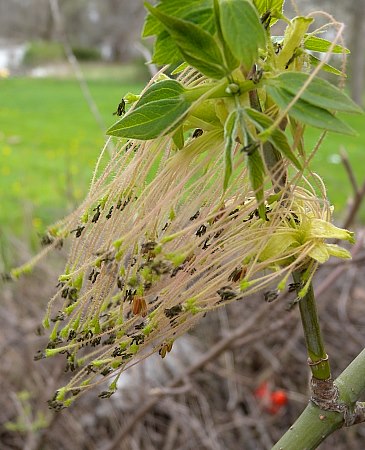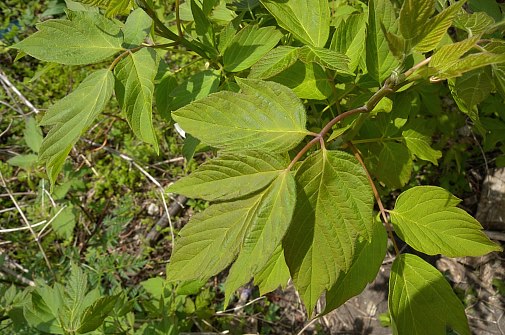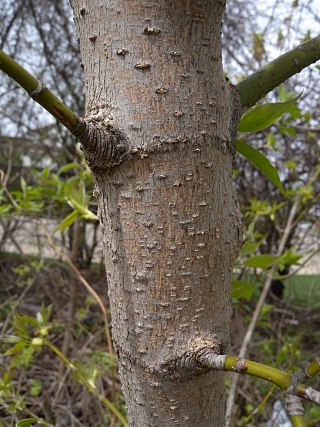Description: This is a small tree up to 60' tall with a trunk up to 3' across. It branches abundantly and has a broad well-rounded crown. On old trees, the gray bark forms deep curving furrows, while the gray bark of young trees forms furrows that are shallow and more erratic. Young branches are olive green and smooth with scattered white lenticels; less often, they are purple. The leaves develop oppositely from each other on young shoots; they are odd-pinnate with 3-7 leaflets. The leaflets are 2-4" long and about half as much across; they are more or less ovate in shape, coarsely dentate, and often shallowly cleft. Sometimes the terminal leaflets are moderately cleft to form 3 distinct lobes. The upper leaf surfaces are yellowish green, light green, or medium green, while the lower leaf surfaces are pale green and either hairless or slightly pubescent. Each leaflet has a short slender petiole at its base. The rachis (central stalk) of each compound leaf is hairless and often reddish.

Box Elder is dioecious with male and female flowers on separate trees. Initially, dense clusters of drooping male and female flowers develop at about the same time, or a little ahead, of the leaves during early to mid-spring. Later, the clusters of female flowers elongate into drooping racemes. The male flowers have pedicels that are long, slender, and hairy. Each male flower consists of 5 small green sepals, no petals, and about 5 exerted stamens. The large anthers of the stamens are dark red initially, although they later turn brown before withering away. Each female flower has 5 greenish red sepals, no petals, and a pistil with a long style that is deeply forked. The flowers are wind-pollinated. Each female flower is replaced by a pair of samaras (winged seeds). Each samara is 1–1Ĺ" long. The samaras are initially green, but they later turn brown and often persist on the tree through the winter. The root system is woody. Vegetative shoots from underground runners are not produced.

Cultivation:
Box
Elder tolerates a wide range of conditions, but it is typically found
in areas with partial to light shade and above-average levels of
moisture. This tree tolerates practically any kind of soil, including
heavy clay, sand, deep loam, and gravelly or rocky material. Growth and
development is faster than most trees, but it is short-lived and prone
to storm-breakage. Flooded conditions that last up to one month can be
tolerated.
Range & Habitat:
The native Box Elder is common throughout Illinois; it can be found in
all
counties (see Distribution
Map). Habitats include floodplain forests, open disturbed
woodlands, woodland edges, thickets, river banks, fence rows, shallow
ditches, roadsides, areas near bridges, and urban waste areas.
Sometimes Box Elder colonizes upland habitats as well if they are not
too shady. Generally, habitats with a history of some disturbance are
preferred.

Faunal Associations:
Insects that feed on Box Elder include Contarinia negundinis
(Box Elder Gall Midge), Boisea trivittatus (Box
Elder Bug), Periphyllus negundinis (Box Elder
Aphid), the larvae of several moths, and other insects (see the Insect Table
for a listing of these species). Bird that feed on the seeds of Box
Elder include the Evening Grosbeak, Purple Finch, Pine Grosbeak, and
Ring-necked Pheasant (DeGraaf, 2002). Tanagers, warblers, and other
birds forage for insects on Box Elder (see Bird Table).
Birds also use this tree for protective cover and nesting habitat; this
latter group of species includes the Common Grackle, Yellow Warbler,
Cerulean Warbler, Red-bellied Woodpecker, Eastern Screech Owl, and
Veery (Homan et al., 1996; DeGraaf, 2002; DeVore et al., 2004; Jackson,
1976; Belthoff & Ritchison, 1990; Heckscher, 2004). Among mammals,
the twigs and branchlets are browsed by the White-tailed Deer and
American Moose during winter, while the Hoary Bat (Lasiurus cinereus),
Evening Bat (Nycticeius humeralis), and Tricolored Bat (Perimyotis
subflavus) use this tree as a roosting site or for maternity colonies
(Ludewig & Bowyer, 1985; Baerwald et al., 2012; Shimp & Shimp,
1982; Mužnzer, 2008; Veilleux et al., 2003).
Photographic Location:
Photographs of the male flowers and trunk were taken near a fence row
in Urbana, Illinois, while the photograph of the compound leaves was
taken at a thicket along a railroad in Champaign of the same state.
Comments:
Box Elder is a very unusual Acer sp. (Maple)
because of its compound leaves. However, it produces pairs of samaras
(winged seeds) that closely resemble those of other trees in this
genus. Another unusual characteristic is the olive green bark of the
branches. This bark later becomes more rough and gray as it matures.
Because of the similar appearance of their compound leaves, it is
possible to confuse young shoots of Box Elder with Poison Ivy
(Toxicodendron radicans). Unlike Box Elder, the leaves of Poison Ivy
never have more than 3 leaflets, and the flowers and fruits of these
two species are quite different.